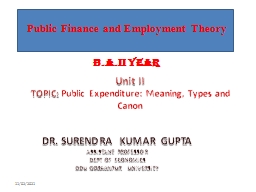

KUMAR GUPTA ASSISTANT PROFESSOR DEPT OF ECONOMICS DDU GORAKHPUR UNIVERSITY Unit II TOPIC Public Expenditure Meaning Types and Canon Public Finance and Employment Theory 11022021 OBJECTIVES ID: 1027522
Download Presentation The PPT/PDF document "B.A.II Year DR. SURENDRA" is the property of its rightful owner. Permission is granted to download and print the materials on this web site for personal, non-commercial use only, and to display it on your personal computer provided you do not modify the materials and that you retain all copyright notices contained in the materials. By downloading content from our website, you accept the terms of this agreement.
1. B.A.II YearDR. SURENDRA KUMAR GUPTAASSISTANT PROFESSORDEPT OF ECONOMICSDDU GORAKHPUR UNIVERSITYUnit II TOPIC: Public Expenditure: Meaning, Types and CanonPublic Finance and Employment Theory11/02/2021
2. OBJECTIVESIn the Previous Class: Discussed about Effect of TaxationEffect of Taxation on ProductionEffect of Taxation on Reallocation of ResourcesEffect of Taxation on Income Distribution In this class we will know;Meaning of Public Expenditure Types and Canon of Public Expenditure
3. Meaning of Public Expenditure Expenses incurred by the public authorities central, state and local self- governments are called public expenditure.Such expenditures are made for the maintenance of the governments as well as for the benefit of the society as whole.Public expenditure was denied for a long time. Public expenditures must be kept low as far as practicable. This conservative thinking died down in the twentieth century, especially after the Second World War. As a modern state is termed a ‘welfare state’, the horizon of activities of the government has expanded in length and breadth.There is many reasons for enormous increase in public expenditure throughout the world even in the capitalist countries where laissez-faire principle operates. 11/02/2021
4. Public expenditure may be classified into developmental and non-developmental expenditures. Developmental Expenditure includes the expenditure incurred on social and community services, economic services, etc. Non-developmental expenditure includes expenditures made for administrative service, defence service, debt servicing, subsidies, etc.11/02/2021Types of Public Expenditure
5. It may also be classified into revenue expenditure and capital expenditure. Revenue expenditure includes civil expenditure (e.g., general services, social and community services and economic services), defence expenditure, etc. Capital expenditure comprises expenditures incurred on social and community development, economic development, defence, general services, etc.Public expenditure may also be classified as plan expenditure and non-plan expenditure.11/02/2021Conti………………………………………
6. Rules or principles that govern the expenditure policy of the government are called canons of public expenditure. Fundamental principles of public spending determine the efficiency and propriety of the expenditure itself. While making its spending programme, government must follow these principles. These principles, in short, are called canons of public expenditure.Findlay Shirras has laid down the following four canons of public expenditure:(i) Canon of benefit(ii) Canon of economy (iii) Canon of sanction(iv) Canon of surplusCanon of Benefit:According to this canon, public spending has to be made in such a way that it confers greatest social benefits. In other words, public expenditure must not be geared in such a way that it provides benefits to a particular group of the community. Thus, public expenditure is to be made in those directions where general benefits rather than specific benefits flow in.However, often public expenditure is incurred for the benefit of a particular group (say, dalits, tribals). This sort of public expenditure does not violate canon of benefit. Any public expenditure for the development of a backward area does promote social interest.11/02/2021Canons of Public Expenditure
7. Canon of EconomyEconomy does not mean greediness. It refers to the avoidance of wasteful and extravagant expenditure. Public expenditure must be made in such a way that it becomes productive and efficient. Efficiency in public expenditure requires economy of expenditures. To enjoy the maximum aggregate benefit from any public spending programme, it is necessary that the canon of economy is observed. An uneconomic expansion in public expenditure will result in scarcity of funds, the much-needed growth of the productive sectors will be hampered. This means lower social benefit. It is thus obvious that the canon of economy is not independent of the canon of benefit.Canon of Sanction:The canon of section, as suggested by Shirras, requires that public spending should not be made without any concurrence or sanction of an appropriate authority. Arbitrariness in public spending can be avoided only if spending is approved. Further, economy in public spending can never be ensured if it is not sanctioned.11/02/2021
8. Canon of SurplusThis canon suggests the avoidance of deficit in public spending. Like individuals, saving is a virtue for the government. So the government must prepare its budget in such a way that government revenue exceeds government expenditure so as to create a surplus. It must not run deficit to cover its expenditure.However, modern economists do not like to attach any importance to Shirras’ fourth canon— the canon of surplus. To them, deficit financing is the most effective means of financing economic programmes of the government.11/02/2021
9. Reference S. K. Singh, Public Finance in Theory and Practice, Ninth revised Edition, 2014/ reprint 2018.B. P. Taygi, Public Finance, First Edition, 1975.R.A. Musgrave and Musgrave P.B, Public Finance in Theory and Practice, Fifth Indian Edition and 23rd reprint, 2019. आर . के. माहेश्वरी, लोकवित्त सिद्धांत एवं व्यवहार, छठा संशोधित संस्करण, 2002.एस0 एन0 लाल और लाल एस0 के0, लोकवित्त (रोजगार सिद्धांत के साथ), पूर्ण परिवर्धित तथा संशोधित संस्करण, 2017.एस0 एन0 लाल और लाल एस0 के0, भारतीय अर्थव्यवस्था,सर्वेक्षण तथा विश्लेषण, पूर्ण परिवर्धित तथा संशोधित संस्करण, 2018.
10. THANKS11/02/2021